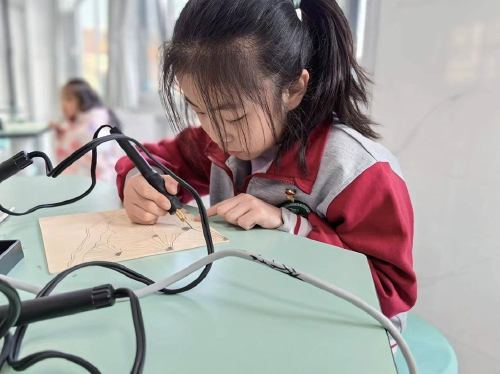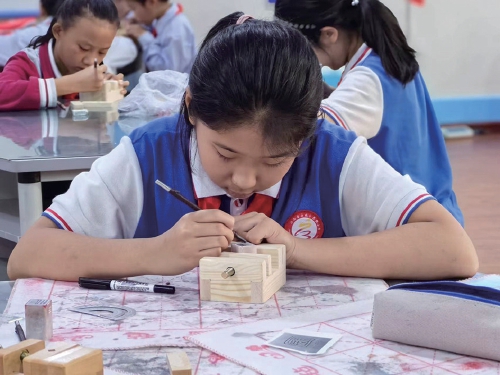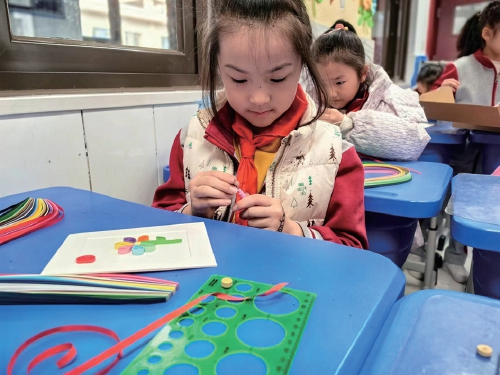In recent years, Jinan has continuously explored the construction of a long-term mechanism for non-legacy to enter the campus, further stimulating young people’s interest in Chinese excellent traditional culture, and allowing non-legacy seeds to take root and blossom on campus.
The sand painting version of "Meng" Nalisa, the dough modeling version of the cute giant panda, the paper-cut version of 56 ethnic groups singing and dancing, the vivid Four Great Classical Novels leading group carved on the porcelain board, and the shadow play version of "Mouse Marrying" … … Recently, the 2024 Jinan Intangible Heritage Exhibition was held in the Municipal Cultural Center. More than 400 pieces of "fun and cute" intangible heritage works from more than 20 projects, including Jinan Shadow Play, Jinan Micro Sculpture, Lu Embroidery, Jinan Face Sculpture, Jinan Porcelain Carving, Jinan Egg Sculpture, Social Fire Mask and Jinan Paper-cutting, designed and created by the city’s primary and secondary school students, were unveiled, showing that students inherit intangible heritage skills and love traditional culture.

Primary and secondary schools have become an important base for non-genetic inheritance.
At the entrance of the exhibition of "Intangible Heritage and Childlike Interest", several exquisite paper-cuts caught the attention of visitors. On the background of blue pearl paper, black paper-cut forms an image of carp jumping over the dragon gate. In the billowing waves, a dragon gate stands tall, and a carp that has successfully jumped over the dragon gate has turned into a dragon, and there are still fish around trying to jump. This paper-cut work with vivid shape and beautiful meaning was written by deaf-mute students in Jinan Special Education Center.
In 2020, Jinan Special Education Center opened a paper-cutting course, and signed the "Teaching Agreement on the Integration of Intangible Heritage and School Education" with Wang Tao, a representative inheritor of Jinan Municipal Intangible Heritage. Wang Tao went to school every Thursday afternoon to give paper-cutting lectures to students. After several years’ study, the students’ paper-cut works have been exhibited in Jinan Cultural Center and other places for many times, which has been recognized and praised by the society, and won prizes in the Sixth Disabled Skills Competition and the Handicraft Skills Competition of Jinan Intangible Cultural Heritage.
According to the relevant person in charge of Jinan Culture and Tourism Bureau, since the implementation of the "Non-genetic Inheritance and School Education Integration Project", various schools have carried out different forms of activities due to the differences in teaching characteristics, students’ acceptance and non-legacy projects. Some offer fixed courses; Some are daily training, such as the "drum yangko into the campus" carried out by the First Experimental Primary School in Shanghe County, and practicing "drum yangko exercise" during the broadcast gymnastics period in the school. Through all kinds of "campus-going" activities and courses, students have planted intangible seeds in a subtle and quiet way, expanding the ways of non-genetic inheritance.
Since the official launch of the "Non-genetic Inheritance and School Education Integration Project" in Jinan in 2018, municipal financial funds have been allocated to subsidize the project inheritors who teach on campus, and a complete guarantee system has been established; The school is responsible for providing and ensuring teaching facilities. The education and cultural departments closely communicate and coordinate, integrate resources, promote the integration of non-legacy and school education in a wider scope, and actively create "non-legacy courses that cannot be taken away". Since the implementation of the project, 159 primary and secondary schools have been supported to sign teaching agreements with non-genetic inheritors, and non-legacy courses such as dough sculpture, paper-cutting, shadow play and drum yangko have been offered in schools, which have achieved remarkable teaching results and are welcomed by students and parents. In 2020, our city’s "practical case of non-genetic inheritance and school education integration project" was selected as one of the top ten outstanding practical cases of the second national "non-legacy into campus", and primary and secondary schools have become an important base for non-genetic inheritance.

Exploring the Integration of Intangible Cultural Heritage into National Curriculum Teaching
In the exhibition of "Intangible Heritage and Childlike Fun", the paper work "Twenty-four Solar Terms" of Yi ‘an Primary School attracts people’s attention. The works selected the corresponding plants of the twenty-four solar terms, namely, the peach blossom in Qingming, the lotus flower reflecting the sun in summer, the autumn chrysanthemum Ao Shuang in cold dew, and the Ao Mei Ling Ling &hellip in cold; … The works are elegant in color matching, delicate and lovely.
Qiao Jiyong, the person in charge of Jinan Aifei Cultural Media Co., Ltd., who is responsible for the after-school delay service of Licheng No.2 Middle School, introduced that the schools affiliated to Licheng No.2 Middle School Education Group have set up a variety of non-legacy courses, covering pyrography, paper-cutting, seal cutting, woodworking, dough sculpture, shadow play, silk enamel, guqin, traditional dance, dough sculpture, pottery, traditional drama and other projects. Each school’s non-legacy courses also have their own characteristics, such as pyrography, paper engraving, seal cutting and Shandong fast writing in Yi ‘an Primary School, and leaf carving course in Mingrui Primary School has been held for more than five years. Renxuan Primary School has set up shadow play and paper-cutting. Courses such as guqin, carpentry and children’s opera in Jiaxuan School have also been carried out smoothly.
Since the start of the integration project of non-genetic inheritance and school education, many schools in Jinan have established a long-term teaching system of non-legacy and set up school-based courses, which has enabled the non-legacy projects to be inherited and developed.
Rich and colorful courses allow students to widely contact and learn intangible culture, but they still can’t achieve "comprehensive popularization". Therefore, the relevant staff of tianqiao district Culture and Tourism Bureau began to think about how to integrate intangible culture into national curriculum teaching.
Since 2020, under the guidance of Jinan Culture and Tourism Bureau, tianqiao district Culture and Tourism Bureau has carried out extensive research on the topic of "Research on Intangible Cultural Heritage Practice Based on National Curriculum Standards". After three years of practical research, the inheritors and front-line teachers are guided to provide "heterogeneous classes in the same class" and "double-qualified classes" through the effective links between the contents of national curriculum textbooks, the implementation of teaching objectives and the 10 categories of intangible cultural heritage. Based on the national curriculum standards, intangible cultural heritage can be grafted with local intangible cultural heritage resources to construct a teaching resource package, which is combined with manual materials, videos, images, pictures and words to form a complete teaching system, systematizing and standardizing intangible cultural heritage courses and becoming a cultural course with stable output. In addition, through the practice of the project, it has transformed "non-legacy into campus" into "non-legacy". At present, the research has provided 6 demonstration lessons of Jinan’s intangible cultural heritage practice, developed more than 30 sets of intangible cultural heritage related teaching products, and published "Demonstration Lessons of Primary and Secondary Schools — — Based on the national curriculum standards. "Research on Intangible Cultural Heritage Practice Based on National Curriculum Standards" effectively integrates resources, provides a large number of teachers for schools, and effectively protects intangible cultural heritage.

School teachers become non-genetic inheritors
In 2017, Wang Sheren No.2 Experimental Primary School introduced "Baoshan Porcelain Carving" into the school-based curriculum under the leadership of President Gao Jianzhong, the founder of Baoshan Porcelain Carving, and offered a porcelain carving class in grades four to six, with one class every week. Since 2017, more than 3,000 students have studied porcelain carving.
In 2016, as a teacher of comprehensive practical activities, Gao Jianzhong decided to regain his childhood porcelain carving skills, and joined Shan Mengbo, a representative inheritor of Jinan egg carving and porcelain carving, and began to study systematically. From the teacher to the inheritor, and then to the non-genetic inheritor, in the process of non-legacy into the campus, some ordinary teachers with hobbies and specialties formally became "professional teachers" with non-legacy professional knowledge.
Wang Sheren’s Second Experimental Primary School invited Shan Mengbo as the guidance consultant, Gao Jianzhong as the coach, and the two teachers and apprentices taught each other, constantly enriching the connotation and extension of porcelain carving. From the carrier, from porcelain plate to porcelain plate to porcelain bottle; From the content point of view, from sporadic creation to the theme and serialization of "Twenty-four solar terms" and "Four Great Classical Novels". In just a few years, students have emerged in various cultural fairs and art competitions, and the number of winners has reached more than 400. In the "hard work" experience, the students’ sculptures are becoming more and more detailed. For example, every hair of a character and every texture of a plant leaf are vividly portrayed.
In 2018, Huang Zhaoquan, an art teacher at Luokou Experimental School, began to study and study pyrography with Li Qingfen, the inheritor of pyrography in Jinan. He not only inherited his pyrography skills, but also combined his hobbies and non-legacy into the campus, opened pyrography classes in the school, and trained a batch of non-legacy "gourd dolls".
In the exhibition of "Intangible Heritage and Childlike Interest", there are also some related works of Jinan Shadow Play brought by two high schools, Jigang High School and Jinan Experimental High School. Zhao Shuyan, head of the Shadow Play Studio in Jigang High School, introduced that in 2014, the school established the Shadow Play Society with the help of Li Juan, the provincial inheritor of Jinan Shadow Play, a national intangible project. A shadow play, from script creation, painting design, carving technology, to language performance, sound effect configuration, props control, etc., is constantly studied by school teachers, consulted by experts, and then passed on to students. After 10 years’ teaching practice research, it has formed a model of "compulsory for all senior one students+elective characteristic clubs for senior two students+creation and performance of shadow play art festival". On the basis of inheriting the artistic characteristics of classic shadow play, students
Self-writing, self-making, self-directing and self-acting have realized the innovation from script to stage, from materials to technology, and formed a unique school-based curriculum of fine arts suitable for high school students.
Cultivate students’ interest inSocial and cultural responsibility
The person in charge of the school and the non-genetic inheritors unanimously said that the children’s response to learning is generally very positive. They are full of curiosity and interest in these cultural forms with strong regional characteristics and are willing to invest time and energy in learning and practice.
Gao Jianzhong, Wang Tao, Qiao Jiyong and others believe that learning non-legacy skills such as porcelain carving and paper-cutting can first improve children’s concentration, observation and imagination, and cultivate their practical ability and creative thinking; Secondly, it can cultivate children’s team consciousness, because many large-scale works need group creation, and how to compose and layout requires team efforts. Thirdly, intangible cultural heritage is also an important resource of aesthetic education.
In 2023, Jigang High School and Jinan Experimental High School jointly hosted the exhibition of "New Yellow River, New Education and New Curriculum", which promoted the rapid growth of the school-based curriculum construction of shadow play in Jinan Experimental High School. Zhang Yiming, from Class 23, Grade 2022, said: "I mainly play the role of commentary, director and organization and coordination team. Commentary has played my specialty in Allegro storytelling, and the director has improved my organizational ability." He He, from Class 25, said, "My main role in the activity is ‘ Gonggong ’ The design and dubbing, when I create the imaginary artistic image with smooth lines and strong colors, I feel that Gonggong ‘ Live ’ Well, I am proud that my creativity can be perfectly presented. " Song Jianghan of Class 27 said: "When all the students in our class recited" Young China’s Theory ",we were impassioned and filled with tears. As teenagers in the new era, we are descendants of the Yellow River, we are the hope of the nation, and we are proud of having a great motherland with a long history and innovative development!"
Gao Jianzhong introduced that Baoshan’s non-legacy course of porcelain carving has formed its own classroom characteristics in the process of development. For example, in the series of Four Great Classical Novels, students learned about the vivid characters in the famous works through books or film and television dramas, and then carved them to make them come to life. The whole process not only enhanced students’ understanding of the connotation of the famous works, but also innovatively inherited and developed the excellent Chinese traditional culture. Students are influenced and infected in a strong cultural atmosphere, which improves their cultural quality and has high practical value. "In the process of continuous improvement of the curriculum system of" Carving Porcelain in Baoshan ",students have more understanding of local culture and enhanced their sense of identity and pride in national culture. It also makes students realize the importance of protecting and inheriting intangible heritage, and cultivates students’ sense of responsibility for society and culture. "
Intangible heritage is the precious spiritual wealth of the Chinese nation, which contains rich historical information, profound cultural heritage and unique artistic charm. Introducing intangible cultural heritage into campus can not only provide students with opportunities to contact and learn traditional culture, but also stimulate creativity and imagination and cultivate cultural self-confidence and national pride. By building a long-term mechanism for non-legacy to enter the campus, Jinan will further let non-legacy seeds take root and blossom on campus. This is not only conducive to the inheritance and development of traditional culture, but also helpful to cultivate young people in the new era who consciously carry forward and spread national culture, and promote the construction of urban culture and the promotion of urban cultural soft power.
关于作者